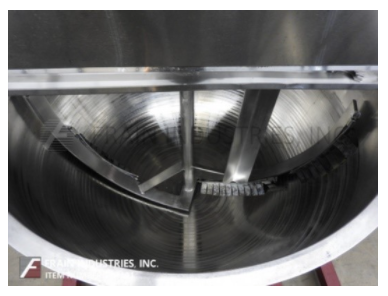The videos below are examples of the Industrial Kettles Frain Carries
Single Motion Kettle Videos
Double Motion Kettle Videos
Triple Motion Kettle Videos
Kettle Without Agitation Videos
Electric Kettle Videos
Gas Kettle Videos
Learn more about Industrial Kettles
Industrial liquid silos are a type of tank used for bulk storage of liquids and semi-liquids. They are commonly storage, as opposed to processing or transport tanks. Their high aspect ratio (height relative to diameter) and non-openable top is what makes them “silos” rather than “tanks”. Silos are often located outdoors though they can be located indoors ceiling height permitting.
Construction is commonly stainless steel though silos can be build of fiberglass, plastic, lined or unlined steel or other materials. The liquid in a tall silo can exert considerable lateral pressure, especially at the bottom of the tank. This would deform a square or rectangular silo so almost all liquid silos are round. Ends can be dished, conical or flat. If flat, it may be desirable for the head to be at an angle for ease of drainage (bottom) and to avoid accumulation of dirt and debris (top head) Outer coverings for physical protection or insulation to avoid large temperature swings may be required for outdoor silos. Silos may be jacketed to allow circulation of steam, hot or cold water or even nitrogen to maintain a constant product temperature.
Suitable fittings and connectors must be provided for filling and draining the silo. Level sensors are required to show how much product is in the silo. Several types are available:
- Mechanical floats connected by wire or magnetically to a scale
- Load cells to monitor the weight of the product in the silo
- Pressure sensors at the bottom of the silo. These convert head into level
Internal spray balls or nozzles may be fitted for automated cleaning if needed.
Manholes are common to allow access to the silo interior if required for cleaning or maintenance.
CAUTION: Confined spaces such as silos are dangerous. Never enter a silo without taking all safety precautions as well as having a second person outside the silo.
Most silos are not built to withstand vacuum. If the silo is emptied without adequate venting, sufficient vacuum can build up which will collapse the silo. If silos are steam cleaned or sterilized, the condensing steam will create enough vacuum to collapse any silo. All silos must have sufficient venting for the worst case scenario. In addition to proper venting, rupture disks are recommended. In the event of excess vacuum, these break allowing emergency venting.
Selecting the proper tank for the intended purpose is critical to proper processing, handling and manufacturing. Tanks can be used for storage, shipping, mixing 2 liquids, mixing a liquid and a powder, heating, cooling, cooking, reacting and dozens of other uses. Here are some things you need to know about them.
- Size matters – Too small and it won’t hold sufficient product. Generally it is a good idea to oversize a tank to allow for future uses. Aspect ratio, the proportion of height to diameter may be determined by the space available but may also impact the product itself especially if the tank is to be used for mixing. Most tanks are vertical round cylinders but these take up more floor space than square tanks. Horizontal cylinders are also used for some applications.
- Stainless steel is a common material for process tanks and is compatible with most, but not all, products. All grades of stainless are not the same and it is important to pick the proper one for your product. Other materials include a variety of plastics, fiberglass, glass lined steel, copper and specialty metals.
- Open or closed? Open tanks may have a loosely fitting cover or not but they are will not hole pressure or vacuum. Closed tanks can be sealed and, generally, pressurized. A tank strong enough to withstand positive pressure is not necessarily strong enough to withstand negative pressure or vacuum. Draining or steaming a tank without proper venting and cause a tank to implode. All closed tanks must have proper pressure relief valves or rupture disks.
- Jackets for steam, hot water or cold water will allow for product temperature to be maintained.
- Some tanks only need 2 openings for product to enter and leave. Many tanks need more. Level and pressure sensors will need fitments. A handhole or manhole may be useful for cleaning and inspection. Mixers or agitators may be required. These must be specified when designing a tank.
There is a lot more to know about tanks. Be sure to match product, tank and application.
Some of the Manufacturers We Carry







Contact Your Engineer
Discuss your application directly with our qualified engineers.
